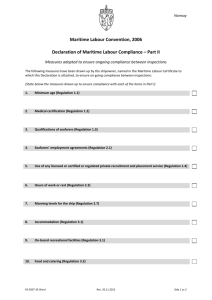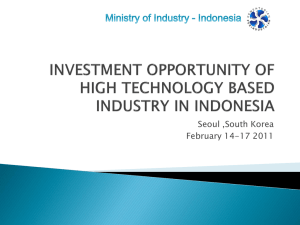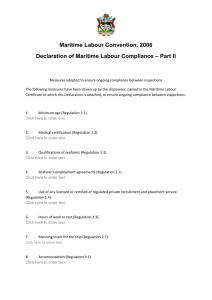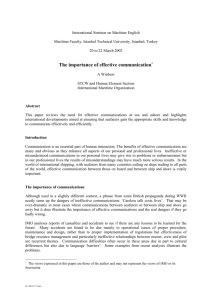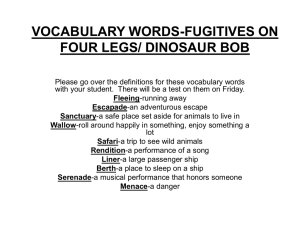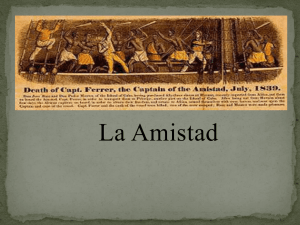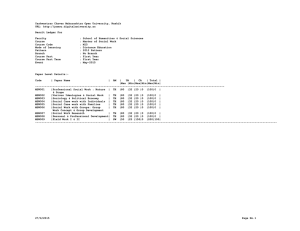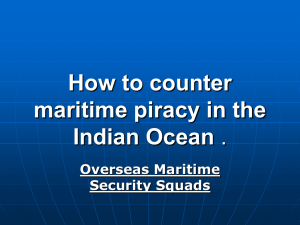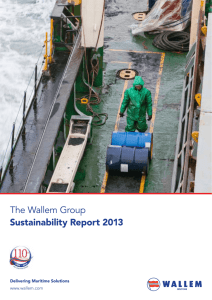Optimizing On-Board Training System in the 21st Century
advertisement
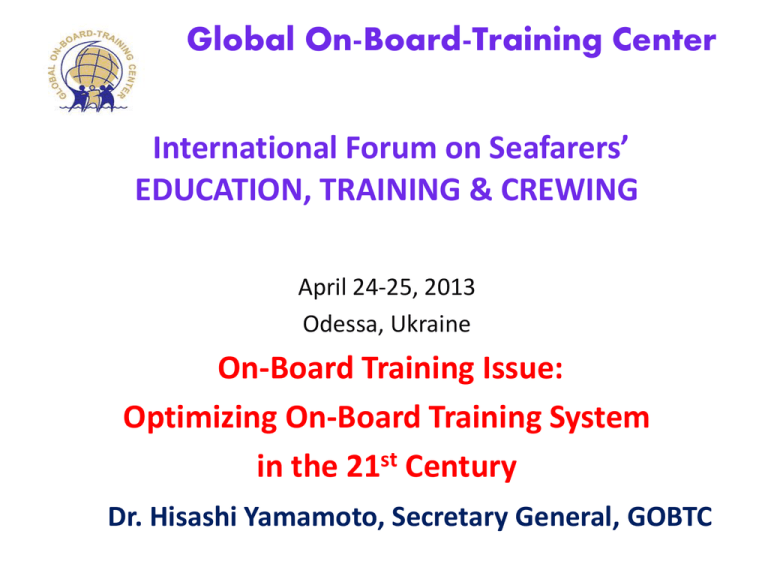
Global On-Board-Training Center International Forum on Seafarers’ EDUCATION, TRAINING & CREWING April 24-25, 2013 Odessa, Ukraine On-Board Training Issue: Optimizing On-Board Training System in the 21st Century Dr. Hisashi Yamamoto, Secretary General, GOBTC Where We Are 1. Divide between Analogue/Digital Generations - “Generation Y” followed by * “Generation Digital” * “Generation Tablet” 2. Shortages: a) Teachers (both Analogue/Digital and on shore and at sea) b) Forward looking Innovative Initiatives Future Perspective (Around 2023) D=Digital, A=Analogue 1. Administrations (incl. CoC exam): D (e.g. Electronic data base by Jan. 2017) 2. Ship: D 3. Industry: D 4. MET Institutions (On Shore): D 5. Students: D 6. Instructors: A 7. Seafarers: Mixture (A > D) Outlook - Methodology • Still picture analysis: NG • Motion picture analysis (Process analysis): G Outlook – General Environment/Trend 1. Technologies overall: Cyber/Digitization 2. Maritime overall: “4S” Integration based on C/D (Conceptual images: Next 2 pages) 3. Maritime Examples: a) Smart Fleet Management b) Official recognition of STCW CoC e-Learning based courses by CMA(UK) and MPA(Singapore) 4S Integration Shipbuilding Sea Transportation Shore management Satellite (Space) 6 4S Integration Smart Fleet Management Long Range Identification and Tracking of Ships (LRIT) Energy Efficiency Design Index (EEDI) Energy Efficiency Operational Indicator (EEOI) Ship Energy Efficiency Management Plan (SEEMP) 7 The New Paradigm of Shipping Now Smart Fleet Management Age has Come “NYK, the biggest Japanese shipping company, announced their successful application of the system to their container fleet. NYK has decided to expand the system application to their LNG carrier, tanker, and pure car carrier fleet. NYK plans to expand the application to all of their owned fleet of more than 200 vessels by 2015.” (Nekkei <Japan Economic Journal> Newspaper, 15th August, 2012) 【Diagram】The Roadmap to The New Paradigm : Integrated System CO2 Minimization Vessel Position Monitoring SEEMP Package Measures Vessel Performance Monitoring System (2010 ~ ) •PDCA in ship performance •Standardization of monitoring devices •Cooperation with EEOI validating body Traditional Weather Routing for Safety (2013 ~ ) The Best Balanced System: Environment, Safety, Economy Optimum Fleet Management •Minimum emission of GHG with SEEMP •Maximization of Voyage Net Proceed •Safety Management at rough seas (2014 ~ 15) Optimum Weather Routing (safety + punctuality + economy) (2010 ~ ) Real Time Weather Routing & Monitoring •Real time communication •Regular measurement of waves & vessel movement •Application of sea-keeping simulation (2012 ~ ) Broadband Network Weather Routing Trial Onboard (2005~2006) Cooperation with Weather Routing (2010 ~ ) Trim analysis Accuracy Improvement of various measuring devices & Modeling •Accurate torque & thrust measurement •Accurate log speed measurement •Accurate fuel consumption measurement •Accurate wind, wave & currents measurement •Ship performance model (2012 ~) Wave Sensor Performance Monitoring Fuel Consumption Monitoring Device (2007~2008) Smart Ship •Minimum emission of GHG •Minimum energy consumption •Response to environmental regulations •Automatic performance model identification (2014 ~) (2010 ~ ) Fleet monitoring (Container ships, 2009~) Performance monitoring (SIMS: Ship Information Management System) (2008 ~ ) Technical Performance Analysis •Ship appendages •Paints •Maine engine governor •New design propellers (2008~ ) Electronic ablog (e-Ablog) Expansion to: PCC, Bulker, Tanker, LNG carrier Feed back to the shipbuilder & new design EEDI validation Performance Validation of Low Emission Machineries •Hybrid Turbo Charger •Battery (Giga cell) •Exhaust gas collection system (2011 ~ ) Outlook – Education: For “Generation C” (Cyber & Change) “Turkey launches ambitious FATİH project in public education” (2012)“ – The aim enabling equal opportunities in education and improving technology in our schools for the efficient usage of ICT tools in the learning-teaching processes by appealing to more sense organs in all 620.000 schools that are in the preschool education, the primary education and the secondary education through providing tablets and LCD Smart Boards. Outlook – Education: Toward “Generation C” (Cyber & Change) Istanbul Technical University today: “Changing the DNA of its higher education to prepare the leading native digital engineers of the future” - Prof. Dr. Muhammed Sahin, ex-Rector till August, 2012 Digital Maritime Reality Quotations: 1. Mr. Sekimizu, SG of IMO for this Forum: “The modern ship’s officer needs to be far more than a navigator or an engineer, and the modern ship’s crewman needs to be far more than a manual labourer. A modern ship is a highly technical workplace operating on the tight margins of commercial viability – which means that, as well as a highly-advanced technical skillset, shipboard staff now also need to be fully conversant with management and communication skills, I.T. knowledge, budget handling and so on.” (Underlined by this presenter) Digital Maritime Reality (cont’d) Quotations: 2. Mr. Andrew Guest: BIMCO Feature: “Generation Y: Making Waves” At a recent Nautical Institute (NI) seminar (“Generation Y – Professional Navigators”), the NI Chief Executive said, “It is absolutely vital that those of us with more extensive maritime experience make a genuine effort to engage with today’s younger generation of seafarers. There is much we can learn from one another, particularly in the area of technology and navigation.” But, he added, the onus was on the older generation to create a “welcoming environment that nurtures and hones the [young seafarers’] undoubted skills and talents”. Each generation tends to think of itself as having something new to say and challenges the status quo, creating the potential for friction with the older generation. Time will tell whether or not this generation, the new technology and modern management methods can create a combination that makes shipping more efficient and safer. (underlines and Italics by this presenter) Maritime Digital Paradox “The more digitization on shore, The more actual demand/rationale for On-Board-Training, both in quantity and in quality” 1. Present seafarer supply countries: CBT should go hand in hand with practical training (OBT) 2. CBT will dramatically increase the number of seafarer supply countries…”e4e” Serious Question Can current world OBT system be sustainable? i.e.: a) Can the concept of “OBT by industry” be valid and optimum in Digital Age, both in quantity and quality? b) Can the industry manage the rapid increase of OBT demands from new seafarer supply countries? Concerning Comment (GlobalMET GenMemo 07-13) “A FIRST TRIP Cadet allegedly was left alone and unsupervised on the bridge in the Dover Straits. The Chief Officer, allegedly drunk, left the bridge at 0600 and did not return. The Cadet, not knowing quite what to do and feeling too intimidated to call the Master, navigated the ship alone until the latter arrived on the bridge at 0800. The Master wanted to know where the C/O was and why the course recorder showed some fairly odd alterations.” -A system fatigue? (theoretically, the C/O should be an qualified OBT instructor officially approved by the flag state administration of the Cadet. Is it sustainable?) New Task for Us Now Designing The New Prototype Seafaring Officers and Human Resources in C-Shipping Age. Who ? How ? Where ? Are we ready….? GOBTC Proposal: “Integrated Global C(yber)-MET System 21” Fresh Thinking, Innovative Action NOW 1. Global New Deal for C-System-fitted OnBoard-Training System 2. True Global Collaboration a) Administrations b) Industries c) Academia/MET institutions d) International body- IMO, ILO, IACS, etc e) GOBTC (Coordinator) Global On-Board-Training Center THANK YOU VERY MUCH Dr. Hisashi Yamamoto Istanbul Technical University Maritime Faculty, Tuzla, Turkey
